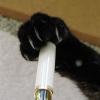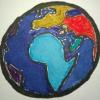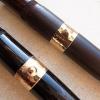Search the Community
Showing results for tags 'stylo art'.
-

Urushi Studio India Goldfish pen impressions and comparisons
jandrese posted a topic in India & Subcontinent (Asia)
I collect urushi and maki-e pens some of which are from India. Here is my Urushi Studio India Goldfish pen impressions and comparisons. First, I show below photos of the pen by itself then photos alongside Japanese pens with the same theme. 398CB59A-8CF7-4757-86E2-23AC7032FC21 by Ja Ja, on Flickr DDD9A3DA-A5A4-482E-87B8-EB2F9251CDF4 by Ja Ja, on Flickr 0AB601B8-1C2D-4B71-8201-AAB972792F21 by Ja Ja, on Flickr 2BE10825-8A09-4EE9-AE61-0F210CF727A9 by Ja Ja, on Flickr D0113742-49BC-4DC8-B125-F1D9C168B868 by Ja Ja, on Flickr Overall, the Urushi Studio India pen is an attractive and unique take on the traditional kingyo (goldfish) theme. The blue base color is remarkable for both the seeming obviousness of using blue when the Japanese use black, and for the difficulty of producing blue urushi. The rocks and goldfish are pleasantly raised urushi especially so the goldfish—the technique is subtle reminding one of the shishiai-togidashi maki-e oft used by Japanese artists when painting kingyo. Comparing the work to three examples of kingyo theme pens from Japanese manufacturers provides some informative contrasts. The three Japanese works are a Danitrio Hyotan by Yusai, a Stylo Art pen featuring Wajima-nuri, and a Namiki Emperor by Seiki. In ascending order of retail price the pens are Urushi Studio India, Stylo Art, Danitrio, and Namiki. The Stylo Art pen is priced only about 15% more than the Urushi Studio India pen whereas the Danitrio is ~2-fold the price and the Namiki tops the scales at nearly 10-fold. 1ED931C6-FA40-4F1A-B873-B8AC7EBE52B5 by Ja Ja, on Flickr The base color of all three Japanese pens is black, that is, polished black oil-free urushi (kuro roiro). The polished black base is highly traditional, glossy, and has a preternatural sense of depth. The Danitrio pen makes this finish a feature, which works well with the curvy shape of the pen, showcasing the perfection of the finish. The other two Japanese pens make use of the black surface more as backdrop for subsequent maki-e work. The black contrasts with the colorful maki-e work but being black does so equally for all colors. Black and gold can also combine to look brown-ish or form a stunningly rich contrast. The polished blue of the Indian pen immediately signals a non-traditional approach while the glossiness of the finish advances its quality. It is said that obtaining consistent blue urushi finishes are difficult so those in the know may appreciate some added difficulty in the preparing the base finish. There are, however, spots of inconsistency in color/gloss speed throughout the blue base coat that are apparent on close inspection. The blue color suggests a realistic depiction of an underwater scene although a more naturalistic color scheme would make use muted earth tones. Being opposite on the color wheel from orange the blue base forms a strong color contrast with the colors used on the goldfish. This is simultaneously attractive and sharply obvious. 21646BA8-3343-4208-9435-A29197FC664D by Ja Ja, on Flickr A bed of rocks are key elements on both the Urushi Studio India pen and the Namiki Emperor. On the Namiki the results are splendid with a multilayered, multicolored believably realistic depiction of a rocky bottom interspersed with foliage. Many maki-e techniques are on display including raised and polished work, multiple metal powder gradients, colored urushi, nashiji, and kirigane (inlaid gold foils). The Urushi Studio India pen also uses multi layered maki-e to depict the rocks yet has a comparative lack of details. The rocks are thickly layered rendered in black with a simple gradient of silver metal particles the texture of which can still be felt. The Namiki better integrates foliage amongst the rock and extends the subsurface to the very end of the pen with nashiji whereas the Urushi Studio India pen leaves a tip of blue at the end of the pen. 2A355D6C-A762-4827-8F2D-92AFAD973A7B by Ja Ja, on Flickr All four pens employ depictions of aquatic plants with the Namiki and Danitrio elevating the work to the highest levels. This is especially so on the Namiki but the clever placement of the plants on the Danitrio along with the the thickness of the lines as well as their subtle color shifts indicate high quality workmanship. The plants are more two dimensional on the Stylo Art pen but the shapes and colors are in keeping with the Namiki and Danitrio pens. The Urushi Studio India pen takes some liberties with its depiction of aquatic plants. The centerpiece looks more like a coral than a freshwater species and the overall color scheme is not as cohesive. The plant colors include silver, red, green, pink, and yellow that lack a sense of being clearly freshwater species that live in the same environment. Two of the pens use bubbles to enhance the underwater scene whereas the other two use gold particles. The bubbles on the Danitrio are rendered with raden, which adds to the visual and textural complexity. On the Urushi Studio India pen the bubbles are silver circles. Rendering the bubbles on the Danitrio is both a higher skill and a more time consuming process. On the Stylo Art and Namiki pens gold particles are used to indicate sand, texture, particles suspended in the water column, and light (the Namiki adds silver particles to enhance the sense of light). The maki-e work on these two pens adds a great deal of dimensionality and dynamism to the scene that is lacking on the less complex pens. 5A787263-2B46-4780-836B-A4F92E5238E5 by Ja Ja, on Flickr Now for the main attraction, the goldfish or kingyo. These pens depict Wakin kingyo, which is the most common kind of Japanese goldfish and the one that forms the basis for all the other types. Kingyo traditionally symbolize wealth, prosperity, and abundance. The red and shimmering gold colors of the goldfish are Summer colors as is green and blue. All four pens offer different depictions of the goldfish. Namiki’s is the most complex visually and artistically. The color scheme of the Danitrio goldfish matches that of the Namiki, and the artwork is similarly delicately raised but the overall approach on the Danitrio is less involved. The fish on the Stylo Art and Urushi Studio India pen are similar to each other although the Stylo Art proves the richer and more complex execution. FF8D6A9A-7FBF-4C15-8031-14E482642850 by Ja Ja, on Flickr Focusing just on the Urushi Studio India pen the goldfish are not shiny as they are on the other three pens. At the risk of anthropomorphizing the goldfish the expression is a frown on the Urushi Studio India pen whereas the others have a neutral expression. The scale lines and the lines on the fins are not regular, which affects the flow of the design causing the eye to wander. The Japanese work is typified by precise, regular, and delicate line work. The micro surface of the Urushi Studio India fish is uneven, which contrasts with the smoothly polished surface of the fish on the other pens. Diffuse and gradient gold particles are used on the Japanese pens to give texture and increase the color depth of the fish. The Urushi Studio India pen does not make use of gold particles except on the lines. The delicate flow of the goldfishes fins are rendered splendidly on the Namiki pen followed closely in effect by the Danitrio then the Stylo Art. The Urushi Studio India pen gives a large surface area to the fins, which is in keeping with the Namiki design but lacks the textural complexity and wispy sense of motion imparted by the Namiki and Danitrio depictions. Uniquely, the Stylo Art pen uses raden for the goldfish eyes, which is an inspired choice that elevates the artwork that otherwise lacks some of the complexity shown by the Danitrio and Namiki fish. In summary, Danitrio goes for simplicity and executes to perfection. Namiki uses complexity and executes to perfection. Neither are easy to accomplish. The Stylo Art and Urushi Studio India pens are in between those extremes although in design terms the Stylo Art is most akin to the Namiki whereas the Dantirio and the Urushi Studio India take a similar similar approach. That the Urushi Studio India pen can comfortably sit beside the Japanese works is impressive. Taken on its own, and seen with the eye not an unrelenting macro lens, the Urushi Studio India pen is a vibrant joy to behold. It has all the visual and textural appeal of good raised maki-e. Given time and increased experience no doubt the relative unevenness in design and execution will improve. It is exciting to see the development of new urushi and maki-e artists outside Japan that are creating new works in their own styles using these traditional techniques.- 11 replies
-
- urushi studio india
- urushi
-
(and 5 more)
Tagged with:
-
Wanted to present my current stable of Stylo Art pens. 1. Akebono/bokashi chinkin butterflies 2. Dragon maki-e 3. Pine tree and cranes maki-e The pen bodies are exclusive to Stylo Art and are large pens being slightly bigger than a Namiki Yukari but are lightweight. I believe the base material is plastic. The akebono chinkin pen has an amazing Pilot #15 nib custom ground by Yukio Nagahara to what is called an N-point. It writes a super smooth and juicy fat line at about 45 degree that gets more narrow as the pen angle is steepened. It's kinda a cross between a Sailor Zoom and Naginata grind sort of, it's doing it's own thing really. The other two pens have stock (?) Pilot stub nibs, which be warned, are really more like cursive italics. Wonderful nibs but a little more demanding than a Western stub. All come with Paulowina wood boxes, pen sleeves, and CON-70 converters. Most excellent pens and more than fairly priced. Highly recommended. capped rotated_SON3728 by Ja Ja, on Flickr capped fan_SON3729 by Ja Ja, on Flickr uncapped_SON3731 by Ja Ja, on Flickr writing sampe by Ja Ja, on Flickr
-
Some time ago, I bought a Stylo Art pen. I think it's a Shirane Honshu model (at least, it looks very similar to the photo on the Stylo-Art website), but I bought it second hand and no longer have a record of the model. I find it beautiful - enough so that I took a chance on the pen - and to date it is my only urushi pen. The problem is the nib. Or rather, an incompatibility between the nib and me. The pen is fitted with a single-tone 21K Sailor H-F nib and, try as I might, I just cannot love it: it writes too fine a line. I know I like the Sailor Medium, so the obvious thing would to somehow get hold of a Sailor M nib and fit it to the Stylo Art pen (or else go the other way and fit something like a Music nib). So, here are my questions: Do I need to know anything special about the kind of Sailor nibs that Stylo Art uses? I assume that they are standard Sailor nibs, but is that right? And I assume they are friction-fit, but is that accurate? Would any other kinds of nib fit? If nobody can help, I'll simply try pulling and replacing the existing nib when I do manage to find a substitute nib. Responses gratefully received, particularly if it helps prevent me from inadvertently destroying anything.
- 1 reply
-
- stylo art
- sailor h-f nib
-
(and 1 more)
Tagged with:
-
http://i.imgur.com/WIYALJz.jpgStylo Art Karuizawa Karuizawa, about 80 miles from Tokyo, is a small town nestled on the slopes of Mount Asama, an active volcano (because: Japan). Famous for its jams and honey, you could be forgiven for thinking this green, leafy, sleepy, place was outside of time and far removed from the world, but its fingerprint on history is larger than its diminutive size: it is the only place to have hosted events at both summer and winter olympics (Tokyo 1964, and Nagano 1998); welcomed Yoko Ono, Jon Lennon and family every summer; was where the current Emperor of Japan met his wife (playing tennis); and was the location from which was sent the telegram ending WWII. Less momentously, my own family history runs long through Karuizawa. This was where my grandparents bought a house in the 1940s, where my mother and her siblings ran through the shaded gardens as Tokyo scorched beneath the scalding summer sun. My own children now play on that same moss, beneath those same trees, and so when I heard about Stylo-Art, a small pen-maker crafting their own creations in such an emotionally resonant location, I knew I had to visit. Motoshi Kazuno and I first tried to arrange a meeting 18 months ago, but Karuizawa is noticeably less in demand as a ski resort than as a summer retreat, and the Kazunos were away visiting relatives. Time passed, and this week I was finally able to make the 30-minute journey through the mountains to the hamlet Motoshi and his wife Shuko call home. Anyone familiar with Japan will understand that this was not a simple undertaking - the address (a series of concentric zones culminating in a radius of a few blocks) dropped me in a semi-rural jumble, and it was only thanks to the photograph of the house kindly sent me by Shuko that I managed to stumble on the little plot and two-story building. I pulled my car onto their driveway (or perhaps their lawn), and waited for a sprightly, deceptively young man in a grey t-shirt to wander out to investigate. This was Motoshi Kazuno, Mr. Stylo-Art himself, and his welcome could not have been warmer. http://i.imgur.com/PkJ0iHB.jpg The 'showroom'. I was invited in and, over iced green tea, learned of Motoshi's progression to pen-maker from salary-man in Tokyo, via existential angst and a short spell in carpentry. With great and well-placed pride he described how he had built, by hand, the home we now sat in as all the while, Shuko looked on with great affection. It is clear that she holds her husband's work in high esteem. http://i.imgur.com/CaQomtx.jpg Shuko and Motoshi Kazuno, and their wood collection. Throughout the living room were scattered trays of pens (most, apparently, being prepared for the upcoming San Francisco pen show) in a rainbow of colours and textures - woods and urushis - clean and ink-stained ("this one is washed with pilot blue black") - as well as maki-e work from "friends" in Wajima and Naoshima. I was led out to the workshop to see the array of woods neatly organised, the lathe and work-table, the frankly indecent collection of drill-bits ("my obsession") and was talked through the three days of work that leads to a completed pen. http://i.imgur.com/RmxWExL.jpg The worktop (and a very few of the vast collection of drill-bits). I must admit that, having browsed Stylo-Arts website, I was unmoved. All the pens seemed flat and lifeless, lacking any delicacy or soul. Nothing could have prepared me for the reality though, for the finished items are impeccably crafted with true care and attention, and each and every wood and embellishment has a unique character - a character carefully enhanced by Kazuno-sans respectful diligence. http://i.imgur.com/QZAdNKB.jpg Ink-stained and urushied pens (the ink used is for fountain pens, among them Pilot Blue-Black and Iroshizuku Momiji). http://i.imgur.com/TDM2oNp.jpgMore ornate urushi. http://i.imgur.com/AITjRAK.jpgMaki-e from Wajima and Naoshima (central two). I fell in love with so many, but he urged me to hold and study each one individually and at length, to feel the weight and density of the material, to explore the depth of the pattern, the way it reflected or absorbed the light, even to raise each pen to my nose and inhale deeply. Over time, I managed to cull from the many to the few. It was the scent that finally swung me - Japanese cedar, light and delicately veined, its gorgeously pungent aroma reminiscent of the tatami mats of my family home, and of long, hot, steaming Japanese baths as the snow falls beyond the window. http://i.imgur.com/z6Ed8w6.jpg My own shortlist. Note: the elastics denote different nib housing - grey for Pilot, red for Sailor 21k. The third from the left would become my pen. Although Motoshi-san crafts pens to accept Pilot, Sailor and Platinum nibs, since Nagahara-sans death it has become increasingly difficult to purchase Sailor nibs in any meaningful quantity. My pen required a Pilot, and so Motoshi pulled from his desk a collection of no. 5, 10 and 15 nibs, and we proceeded, as the sun lowered in the sky and a faint rain fell upon the roof, to whittle them down to a no. 10 FA that he expertly smoothed and coaxed to my hand. It was with this pen that I wrote a quick note in the Stylo-Art visitors book, and learned, with some surprise, that I was the first gaijin (foreigner) to ever make the trip and meet Motoshi and Shuko in their home. The honour was entirely mine. http://i.imgur.com/XbV814R.jpg Motoshi working on my nib.


